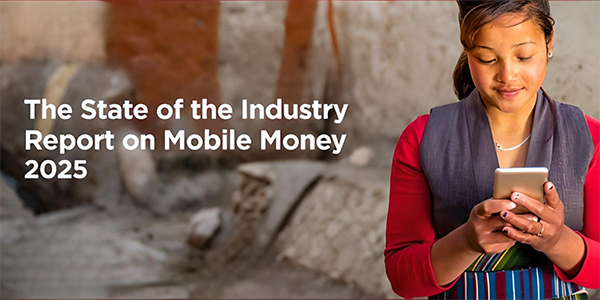Mobile Money : a driver for the global economy
Mobile money continues to transform economies, particularly in Africa, and supports financial inclusion on an unprecedented scale. In 2024, the sector is experiencing a remarkable expansion, reaching record numbers according to the GSMA's annual State of the Industry Report on Mobile Money 2025.

In 2024, the mobile money sector reached a new milestone, according to the GSMA’s annual report titled State of the Industry Report on Mobile Money 2025. This report highlights impressive figures that illustrate the growing impact of this sector, both economically and socially. According to the report, more than 2.1 billion mobile money accounts were opened globally, a 14% increase compared to the previous year. Among these accounts, 514 million are active monthly users, an 11% growth compared to 2023.
Sub-Saharan Africa, with its unique challenges, remains the dominant region in mobile money, with more than 1.1 billion accounts registered
Transaction volumes follow a similar trajectory. In 2024, mobile money transactions totaled $1.68 trillion, or about $3.2 million exchanged every minute worldwide. This figure reflects the growing importance of digital payments in the global economy. Sub-Saharan Africa, with its unique challenges, remains the dominant region in mobile money, with more than 1.1 billion accounts registered.
The main regions benefiting from this growth are East and West Africa. In East Africa, countries like Kenya, with its famous M-Pesa service, have led the way, demonstrating that a mobile payment system can succeed on a large scale. Similarly, in West Africa, services like Orange Money or Airtel Money have seen exponential growth in transaction volumes, facilitating payments in economies often marked by low banking penetration.
The economic impact of mobile money
The economic impact of mobile money is significant. In 2023, countries with mobile money services saw their gross domestic product (GDP) increase by $720 billion compared to comparable countries without such services. This phenomenon is particularly visible in Sub-Saharan Africa, where the direct contribution of mobile money to GDP amounts to $190 billion. This contribution is the direct result of improved financial inclusion, the development of digital commerce, and the reduction of barriers to traditional financial services.
By facilitating access to banking services, mobile money also supports the growth of small businesses. An increasing number of merchants, artisans, and small businesses rely on these platforms for payments, receiving funds, and expanding their markets. This enables better cash flow and creates a virtuous cycle of economic growth.
Financial inclusion and strengthening economic resilience
Another major impact of mobile money lies in its role in financial inclusion, particularly for rural populations and those living in areas where access to banking services is limited. In Africa, where nearly 60% of the population lacks access to traditional banking services, mobile money enables millions of people to access essential financial services such as savings, credit, and insurance.
In Africa, where nearly 60% of the population lacks access to traditional banking services, mobile money enables millions of people to access essential financial services
These services play a crucial role in strengthening the economic resilience of individuals and families. For example, the ability to save via mobile platforms allows individuals to prepare for economic shocks, such as health crises or droughts. Additionally, mobile money has become an essential tool for managing payments during humanitarian crises, particularly in the case of natural disasters or health emergencies.
Financial education and the fight against fraud
The rise of mobile money services has not escaped the importance of financial education. To support this evolution, nearly 60% of mobile money service providers have launched programs aimed at strengthening users’ digital skills and financial literacy. These initiatives are essential as they enable users to better understand how to manage their digital finances, avoid common mistakes, and protect themselves against fraud.
The sector is also actively combating fraud risks. Enhanced security measures, such as identity verification and the use of advanced encryption technologies, are implemented to ensure the security of transactions. User trust in mobile money platforms is a key factor in their continued adoption.
$6 billion in mobile money revenue in 2024 for telecom operators
The mobile money sector is also an important source of revenue for telecom operators. In 2024, major mobile service providers generated over $6 billion in mobile money revenue. This trend is expected to accelerate in the coming years, as the services offered become increasingly diverse, ranging from basic payments to more complex financial products, such as loans and insurance.
The addition of new features, such as microcredit, mobile health insurance, or automated savings services, attracts new users and increases revenue for operators. The business model of mobile money services thus relies on constant innovation, product diversity, and user retention.
The growth of the mobile money industry fuels the transition to digital transactions
“The growth of the mobile money industry fuels the transition to digital transactions, with smaller and more frequent payments, demonstrating the increasing digitization and the growing importance of mobile money in users’ daily lives,” explains Ashley Olson Onyango, head of financial inclusion at GSMA.
The mobile money sector is booming. By 2025, it is estimated that the total transaction volume could increase even further, reaching even higher levels. This growth is supported by the growing adoption of smartphones, the expansion of mobile networks, and the reduction of internet access costs. With these technological developments, mobile money has the potential to become a major lever in the digitalization of the global economy.
The future of mobile money is also marked by the emergence of new technologies, such as blockchains and cryptocurrencies, which could further enhance the security and efficiency of transactions. However, for this growth to be sustainable, it is essential to continue promoting financial inclusion and ensuring the protection of users against potential risks.
Consult the report : https://www.gsma.com/sotir/






